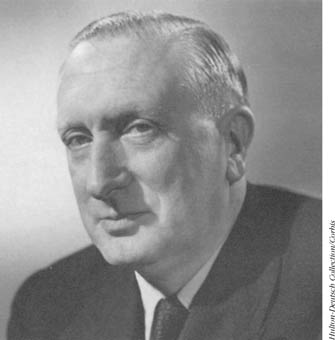
Sir William Walton, whose music included film scores and operas as well as colourful orchestral music.
The works of Sir William Walton have enjoyed both commercial and critical success. At least two major works, Façade and Belshazzar’s Feast, have found enduring popularity with concert audiences, and he has reached a wider audience with his scores for the Shakespeare films of Laurence Olivier.
Walton was born on March 29, 1902, in Oldham, Lancashire. Both of his parents were singing teachers, and his father was a church choirmaster. At age nine, Walton passed the entrance audition for the Christ Church Cathedral School in Oxford, where he remained for the following six years. He excelled at sports, but did not exhibit any prowess in instrumental playing. Instead, he composed music from the age of 11. At only 16 years of age, he became an undergraduate at Christ Church College, Oxford, where he specialised in music history. His compositions there were much admired by a fellow student, Sacheverell Sitwell, whose family gave Walton an allowance and invited him to live with them after Oxford in 1919.
Walton’s Façade, a setting of Edith Sitwell’s poetry made in 1922, with the words recited offstage through a Sengerphone (a kind of megaphone), won him admiration from the many prominent musicians he met through the Sitwells’ artistic circle. Among these were Sir Thomas BEECHAM, who suggested that he write a concerto for the violist Lionel Tertis. Tertis rejected the Viola Concerto, so it was given its first performance by Paul HINDEMITH, and the rapturous reception given to the piece established Walton as a major composer.
Walton’s success continued with the Symphony No. 1 (1935) and a concerto commissioned by violinist Jascha HEIFETZ in 1937. In 1935, he wrote his first film score to Escape Me Never, produced by Herbert Wilcox. This was followed by the Olivier versions of Henry V, Richard III, As You Like It, and Hamlet. The music for Henry V was later made into an orchestral suite.
During World War II, Walton composed music for propaganda films, and also drove an ambulance. The lyrical Sonata for Violin and Piano was written for Yehudi MENUHIN and Louis Kentner. He composed Queen Elizabeth lis coronation march (in 1953) as he had done for her father George VI (in 1937). He wrote many pieces for choir and orchestra during his career, including the wildly exciting Belshazzar’s Feast, with its emphasis on brass instruments, and a Te Deum that was sung in Westminster Abbey in 1953. In 1954, he wrote the opera Troilus and Cressida for Elisabeth SCHWARZKOPF. His last major composition was a cello Passacaglia for Mstislav ROSTROPOVICH in 1982. Walton died on March 8, 1983 in Ischia, Italy.

Sir William Walton, whose music included film scores and operas as well as colourful orchestral music.
fane Prendergast
SEE ALSO: FILM MUSIC; ORCHESTRAL MUSIC; VOCAL AND CHORAL MUSIC
FURTHER READING
Smith, Carolyn J. William Walton: A Bio-bibliography (Westport, CT: Greenwood Press, 1988);
Walton, Susana. William Walton: Behind the Façade (Oxford: Oxford University Press, 1989).
SUGGESTED LISTENING
Belshazzar’s Feast; Coronation March; Façade; Henry V Suite; Symphony No. 1; Troilus and Cressida; Viola Concerto.